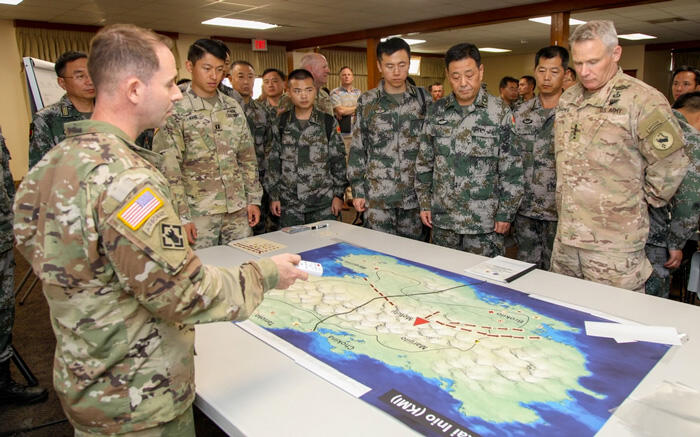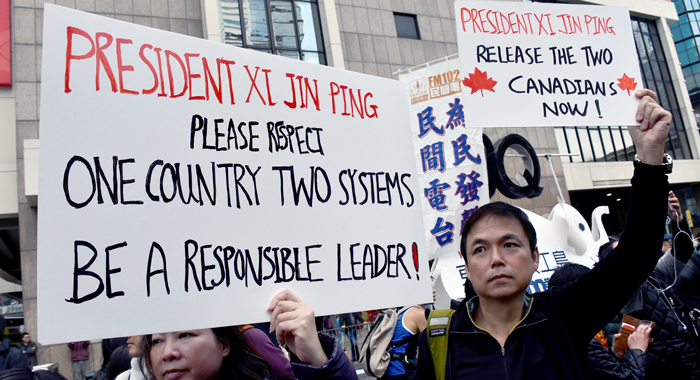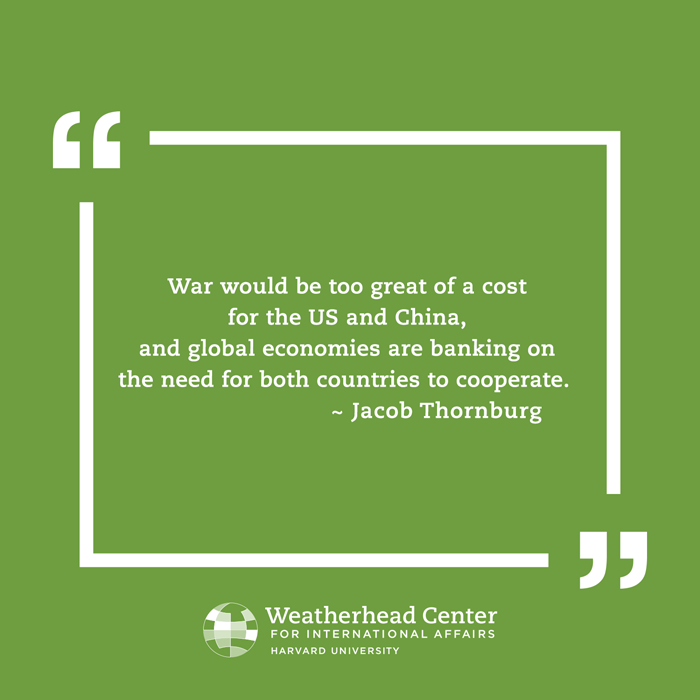US Air Force Colonel and Weatherhead Center Fellow Jacob Thornburg describes the many ways in which China and the US are interconnected and offers measures to shore up the relationship.

By Jacob Thornburg
Last fall, the US and the UK announced a plan to help Australia develop nuclear submarines. It was a bold move that ousted France out of a previously arranged deal to do the same. A nuclear-powered fleet would be a first for Australia, and would represent a strong Western military presence in the Indo-Pacific region. Not surprisingly, China was ruffled and denounced the move as embodying a Cold War mentality.
This trilateral pact, called AUKUS, focuses a spotlight on international relations and raises questions aimed at the precarious US-China relationship. Those who study geopolitics and realism—a school of thought in international relations that emphasizes conflict and competition—and think the US is experiencing a hegemonic downturn, view AUKUS as a gesture to counter and possibly contain a globally ambitious China.
Many scholars and commentators predict that conflict between the US and China is inevitable. I argue that war is unlikely to occur due to the deep economic ties underlying the great power politics between the two countries. To remain off a collision path, however, both countries should aim to strengthen ties wherever possible to maintain peace. There are many ways to do this, notably cooperation at the military level.
Realism theorizes that states will take actions either to maintain power or pursue more power in the name of prioritizing national interests. In this zero-sum worldview, realism would argue AUKUS is yet another example of an agreement taken by the US to limit or contain China’s power, and actions like this—from either side—exacerbate Sino-American tensions and may eventually lead to war. Even as a practitioner of US national defense, I do not see the Sino-American relationship headed this way.
It won’t be easy—the US and China have a fraught relationship, especially with respect to Taiwan’s contentious independence and the territorial disputes in the South China Sea—but the relationship also appears cordial and cooperative at times, particularly in agreements on climate change initiatives. For example, during the recent COP26 (United Nations Climate Change Conference) in Glasgow, China’s lead climate negotiator Xie Zhenhua said, “there is more agreement between China and US than disagreement.” Still, the relationship’s general tone is characterized as tense rather than cooperative. The purported decline of US hegemony and China’s economic rise is at least one cause for tension. If US elected officials fear a decline in US hegemony and believe China will likely fill this global void, then realism would argue the US’s only response is to take action to reverse a hegemonic downfall. This outlook reinforces the lingering perception of a bipolar geostrategic struggle between the US and China today.
The US leverages its instruments of power (diplomatic, information, military, and economic) to counter Chinese growth and expansion. For example, in the Indo-Pacific region, the US Pacific Fleet conducts exercises that are often viewed by China as irritating and aggressive. In response to China’s unfair trade practices that arguably harm American intellectual property rights, innovation, and technology development, the US imposed tariffs on Chinese imports beginning in 2018, kicking off a trade war. More recently, President Biden, appealing to a level of morality and democracy in the information realm, responded to a reporter’s question about competition with China, saying, “this is a battle between the utility of democracies in the 21st century and autocracies,” adding, “we’ve got to prove democracy works.” Here President Biden is signaling to both his domestic and international audience that he believes this is more than just economic competition, and his plan is to take a tough stance on China.
These military and political actions are not surprising. Regardless of the outward reasons the US gives for its political actions, US politicians and many in the Department of Defense (DoD) are afraid of being outpaced by China economically, technologically, and militarily. More poignantly, in roughly the last three years, many DoD leaders have labeled this systemic challenge China presents to the US as “the pacing threat” (and now, as recently as late September, “the pacing challenge.”) Nuances aside, the point DoD leaders are making is that China should be viewed as an adversary—and in many cases, the primary adversary—to the US. This pattern of US behavior begs us to examine China’s political actions.
In line with realism, China employs its political power levers to improve its relative power to the US. According to the US Secretary of Defense’s annual report to Congress, the People’s Liberation Army “conducts influence operations, which target cultural institutions, media organizations, business, academic, and policy communities in the United States, other countries, and international institutions, to achieve outcomes favorable to its strategic objectives.”
Consider the following examples of China flexing its political power. First, in a strategic diplomatic move, the Chinese government recently released two Canadians, held since 2019, who were accused of espionage and labeled a threat to the Chinese government. This release coincided with the US Justice Departments’ deal brokered with Meng Wanzhou, the Chinese chief financial officer of the communications company Huawei, allowing her to leave house arrest in Canada and return to China. While on the surface these events illustrate cooperation between the US and China, it was originally the US that requested Canadian authorities arrest Meng Wanzhou on Huawei’s violations of US-enacted Iranian economic sanctions. This would appear less about cooperation and more a quid pro quo transaction between the two countries.

The second example involves military strength, specifically the numerous times the Chinese have flown military aircraft into Taiwan’s air defense zone. Despite warnings from the Taiwanese military to halt such flights, incursions occurred in late September, early October, and again in November of last year. In all three cases, the Chinese Air Force flew both fighter and bomber aircraft at will, ignoring Taiwanese air traffic controller warnings to alter their course. In response to these incursions, Taiwan continued to launch alert aircraft and activate their air defense systems. Simultaneously, both Taiwan and the US issued statements denouncing these Chinese maneuvers and calling for them to end. This is most likely the exact response China is expecting and more importantly, testing. Planned military incursions test an adversary’s response times, procedures, and tactics. They are also used to normalize the behavior and condition your adversary to believe it is just another show of force. While these recent incursions are without major incident, having them become routine is something Taiwan and the United States should not allow. As more incursions are staged, tensions between Taiwan and China will rise which could lead to an increased risk of miscalculation and misread intentions resulting in a military altercation.
In these examples, China is exercising political power and sending messages to the international community—namely the US—suggesting “we too have military power and will use it at the time and place of our choosing.” As this geopolitical competition unfolds, the looming question is whether or not this unyielding competition will eventually escalate to war, even as a last resort?
Although dogmatic similarities are drawn from the Cold War, when analyzing Sino-American relations, a path to war is not a fait accompli. It’s true we are once again talking about two nuclear-weapon states in an international power competition, but that is where the similarities end. The current political power struggles are different. Namely, the US and China have diplomatic relations and interdependent economies; they are not truly waging a war of ideology, and do in fact agree on—and show they can cooperate on—the need to combat climate change. Yes, President Biden’s previously referenced quote is ideological in nature, but I believe that example is more about using language to invoke emotional support. Ideological differences between the US and China exist, and are somewhat important, yet they matter less than the huge ideological fissure between the US and Soviet Union during the Cold War. In the latter, both sides were trying to export their political ideology to other countries, whereas that is not the case with China, which is more focused on nationalism, and the US, which, after the withdrawal from Afghanistan, appears to be shifting focus domestically.
The power struggle witnessed today is perhaps mutually beneficial, economically and militarily, to both countries. Consider political rhetoric and the influence it can have on foreign policy and public opinion. The stubborn rhetoric from motivated politicians wanting to appear tough on China gives each industrial complex the necessary leverage for growth in the form of military funding to modernize, and the social drive to innovate and invest in new technologies. Such military modernization might recall the arms race of the Cold War. However, again, the key difference between then and now is the unquestionable economic interdependence of the world’s two largest economies, which can be demonstrated by trade data.
According to a February 2021 Congressional Research Service report, China was the largest US goods trading partner in 2020, with an estimated $659.5 billion (combined exports and imports). Breaking that down, US exports to China were valued at $120.3 billion, and the largest source of US imports is from China at $539.2 billion. As of August 2021, analyzing total trade by the US in goods only, China ranks number three at 13.8 percent while the number one and two spots are held by Mexico (14.6 percent) and Canada (14.5 percent).
All-out war could put these interdependent economic ties in jeopardy. One might argue that war can stimulate economies rather than put them in jeopardy, and while that may be true in the short term, history has shown war has unforeseen economic consequences years later.
Still, at least one financial expert likened the China of today to the Japan of 1941, detailing China’s need for semiconductors today is much like Japan’s need for oil supplies in the 1940s. His counter argument is that China’s inability to gain semiconductors represents a potential reason for armed conflict with the US. While China may show aggression in that scenario, I would argue, executives and lobbyists would compel US elected officials to maintain diplomatic relations rather than pursue armed conflict. We are already seeing this today as pressure increases on the White House to drop tariffs on Chinese goods.
The US and China can and should avoid armed conflict through pragmatic and persistent diplomacy accompanied by precise communication about expectations, particularly as it relates to Taiwan. President Biden’s recent discussion with Xi Jinping reaffirming the “Taiwanese Agreement” that keeps the US neutral on Taiwan’s sovereignty is a type of diplomacy. To avoid war, the US and China must bolster both diplomatic and military ties where they can. Improving communication at the most senior general officer levels of the military is important to specify intent, avoid miscalculation, and overreactions from both sides.

Still another way to improve communication is for the DoD to expand military exchange programs between the US and China on the model of those held in 2020 (e.g., the Military Maritime Consultative Agreement Working Group and the annual functional exchanges like Disaster Management Exchange) to include educational and training opportunities for a small number of US and Chinese military members. Military exchanges should include educational and training opportunities like staff college admittance and basic United States Army Airborne School or initial Air Force Undergraduate Pilot Training as examples.
While hawkish security experts may balk at this idea, even a small number of military exchanges could foster trust, lead to recognition of common goals, and promote more interconnectedness. Also consider that under the Defense Security Cooperation Agency, the DoD already educates roughly 78,000 international military students in various technical, operational, and professional military education programs. Furthermore, in academia, Chinese citizens represent the largest international group studying within the US with more than 317,000 Chinese citizens enrolling in US institutions in 2020–2021.
While military exchange programs are not the panacea to resolving Sino-American conflict, the benefits should not be ignored. Military exchange programs have the potential to improve communication, mutual understanding, and create lasting relationships. Considered in the aggregate, with all actions taken under the umbrella of diplomacy, expanding military exchange programs between the US and China is an overlooked option that should be pursued to avoid war.
The US–China relationship will continue to be one based on stringent, stubborn, and staunch economic, diplomatic, and military competition. Both countries will continue to amplify rhetoric at times and posture themselves as the US attempts to maintain power and China attempts to strengthen power. Nevertheless, competition should not negate cooperation. War would be too great of a cost for the US and China, and global economies are banking on the need for both countries to cooperate. Borderless pandemics have proven cooperation between countries is vital to reduce the spread of deadly viruses, and climate change is not slowing down for the foreseeable future without cooperation from the US and China. The reality is both countries need one another in today’s truly connected and global world. Leaders at the highest levels of both governments would be well served to remember our futures are not written yet—only pragmatic choices and actions will ensure a peaceful one.
The views expressed in this writing represent the personal views of the author and are not necessarily the views of the Department of Defense or of the Department of the Air Force.
Contributor Bio
Weatherhead Scholars Program Fellow Jacob M. Thornburg is a Colonel in the United States Air Force. He served in NATO at the Supreme Headquarters Allied Powers Europe and in Air Mobility Command Headquarters. He holds a master’s degree in Defense Studies and International Relations from King’s College London. He is a pilot with experience flying the KC-135, C-17, and C-40.
Captions
- US-China holds 15th Annual Disaster Management Exchange. The DME is one of the key security coordination events the US conducts with the PLA (The People’s Liberation Army) each year; the DME has matured from basic visits and briefings into a substantive exchange that uses table top and practical field exchanges to focus and facilitate risk reduction and interaction between the US Army and the PLA. Non-DoD endorsement disclaimer: The appearance of U.S. Department of Defense (DoD) visual information does not imply or constitute DoD endorsement. Credit: Staff Sgt. Kevin Martin (public domain via DVIDS)
- Members of the Sydney Anti-AUKUS Coalition (SAAC) participate in a protest in Sydney, Australia, Saturday, December 11, 2021. Members of the Sydney Anti-AUKUS Coalition (SAAC) are holding a protest in opposition to the AUKUS military agreement between Australia, the United Kingdom and the United States, the development of nuclear submarines and war on China. Credit: Steven Saphore/Anadolu Agency via Getty Images
- Hong Kong protestors call for release of two Canadians in Chinese custody, January 2019. Credit: Iris Tong (public domain)
- Taiwan reports new large-scale incursion by China's Air Force into its air defense zone, escalating tensions in the Taiwan Strait. The island's defense ministry said on Sunday that thirty-nine Chinese aircraft including fighter jets and a bomber entered its air defense identification zone. Taiwan's military scrambled jets, issued radio warnings, and deployed its air defense missile systems to monitor the fleet's activities. It's the largest incursion sent by Beijing since October 2021. The incident marks the latest in a series of what Taipei calls "gray zone" warfare designed to both wear out Taiwan's forces by making them repeatedly scramble, and also to test Taiwan's response. Credit: Arirang News
